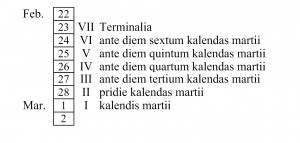Frank King writes “You will, off course, instantly appreciate why I am sending Leap-Year-Day Greetings today, 24 February.”
Readers who need their memories refreshed are referred to the following extract from Frank’s article entitled “Mind the Gap…” in the December 2011 Bulletin.
When is Leap-Year Day?
Sometime after the Paternoster Square noon mark was completed, I received an unexpected e-mail suggesting that 29 February was the wrong date to choose for the thin strip and that the correct date of the intercalary day is 24 February. To quote from the message:
As far as I know nobody, at least in this country, has formally moved it from day 55 in the year (starting January 1st). In any case, who would have authority to do so?
This message could not be lightly dismissed. It was from John Chambers, former Head of the UK Time Service at the National Physical Laboratory, whose responsibilities included overseeing the broadcast of the Greenwich Time Signal. Some explanation is necessary!
The general arrangement of our calendar has been inherited from Roman times. The names of the months differ very slightly from the Latin equivalents and the lengths of the months are unchanged. The principal difference is the way a particular date is identified. The following figure illustrates some terminology.
The main column of numbers shows the last week of February and the first two days of March as they might appear in a modern calendar. The Latin on the right shows how the Romans would have identified the dates from 23 February to 1 March.
The Romans counted dates backwards, rather as we talk of so many days before Christmas. Likewise, the display on the countdown clock currently in Trafalgar Square indicates how many days there are to go before the start of the 2012 Olympic Games.
The first day of each month was a major reference and, for the last few days of February, the Romans counted backwards from the first day of March. In Fig. 6 this scheme is indicated by Roman numerals and note that 1 March counts as I. There was no zero and the VI alongside 24 February indicates six days up to and including 1 March.
The Latin is now fairly easy to follow. The reference day kalendis martii translates as ‘on the first day of March’. Pedants may note that kalendis is ablative plural. Rather as the English word ‘scissors’, the Latin for ‘the first day of’ is always plural. It is ablative to indicate ‘on some point of time’. The word martii is, strictly, an adjective qualifying a hidden mensis. Together, this pair of words means ‘of the martial month’.
Most of the dates shown begin with ante, a preposition which takes the accusative, so the ending of kalendis changes and ante kalendas martii means ‘before the first day of the martial month’.
Following ante, there is an indication of how many days there are to go. Thus ante diem sextum means ‘on the sixth day before’. Interestingly, diem sextum is accusative when it should strictly be ablative, die sexto, to indicate ‘on some point of time’ as with kalendis.
In pre-classical Latin ante die sexto was indeed written but, to Roman ears, the ablative after ante did not sound right and by classical times the case had changed, an early example of sloppy use of language!
The anomalous pridie simply means ‘on the day before’. This leaves only Terminalia unexplained. Terminus was the god of boundaries or endings and 23 February each year was marked by a festival in his honour called Terminalia. When the Julian calendar was introduced, the day following Terminalia was deemed the appropriate place to insert the extra 24 hours required in leap years.
Instead of adding an extra day, the Romans deemed 24 February, in leap years, to be a single day 48 hours in length. This day was called ante diem bis sextum kalendas martii, with bis meaning twice.
It is this nomenclature which gives rise to the term ‘bisextile year’ found in the Book of Common Prayer. The curious 48-hour day was eventually recognised as two separate days but, importantly, it was the first of the two that was considered to be the intercalary day. A modern pedant might therefore write the dates of the last week of February in a leap year as:
23, 24′, 24, 25, 26, 27, 28
Modern practice might be considered merely a relabelling:
23, 24, 25, 26, 27, 28, 29
This relabelling does not change the fact that 24 February is strictly the extra day if not the extra date.
It seems unlikely that many people are greatly troubled by the above analysis but in the late 1990s both Sweden and Finland formally enacted legislation to change the intercalary day from 24 February to 29 February.
One of the few manifestations of this change relates to the Saint’s day for St Matthias. Finnish almanacs for 1996 show his Saint’s day transferred from the usual 24 February to 25 February on account of the leap year but almanacs for 2000 show his Saint’s day retained at 24 February. The Roman Catholic Church ducked this problem by moving the Saint’s day to 14 May but that was to avoid occasionally having to celebrate St Matthias’s Day in Lent!
Summary
Designers of sundials who wish to include calendars on their instruments should consider inserting a special short day to extend the year to match the length of the tropical year.
While most designers would consider that the right place to insert this short day is between 28 February and 1 March, super pedants should insert this short day between 23 February and 24 February.
